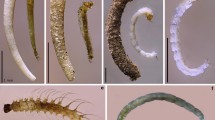Abstract
Each of fourFucus species occurring on the Atlantic coast of Canada was presented to two species of gammarid amphipods in no-choice and multiple-choice laboratory experiments. We also measured concentrations of anti-herbivore phlorotannins in each of theFucus species. The study site was Cranberry Cove in Nova Scotia, Canada, and experiments were conducted in 1988. In a multiple-choice experiment,F. vesiculosus was very heavily grazed. Other species were much less affected. In a no-choice experiment,F. evanescens, F. spiralis andF. vesiculosus were eaten at similar rates, whileF. distichus was barely grazed. These results correlate with measurements of phorotannin concentrations in each of the species.F. distichus had much higher concentrations than did the other species (which were not significantly different among themselves). There is no general clear-cut relationship between grazer deterrence and competitive capability within the fucoid guild studied.
Similar content being viewed by others
Literature cited
Barker, K. M., Chapman, A. R. O. (1990). Feeding preferences of periwinkles among four species ofFucus. Mar. Biol. 106: 113–118
Chapman, A. R. O. (1990). Competitive interactions betweenFucus spiralis L. andF. vesiculosus L. (Fucaleas, Phaeophyta). Hydrobiologia 204/205: 205–209
Chapman, A. R. O., Johnson, C. R. (1990). Disturbance and organization of macroalgal assemblages in the northwest Atlantic. Hydrobiologia 192: 77–121
Denton, A., Chapman, A. R. O, Markham, J. (1990). Size-specific concentrations of phlorotannins (anti-herbivore compounds) in three species ofFucus. Mar. Ecol. Prog. Ser. 65: 103–104
Hay, M. E., Fennical, W. (1988). Marine plant-herbivore interactions: the ecology of chemical defense. A. Rev. Ecol. Syst. 19: 111–145
Howell, D. C. (1987). Statistical methods for psychology. Duxbury Press, Boston
Littler, M. M., Littler, D. S. (1980). The evolution of thallus form and survival strategies in benthic marine macroalgae: field and laboratory tests of functional form model. Am. Nat. 16: 225–244
Lubchenco, J. (1986). Relative importance of competition and predation: early colonization by seaweeds in New England. In: Diamond, J., Case, T. J. (eds.) Community ecology. Harper and Row, New York, p. 537–555).
Ragan, M. A., Glombitzka, K. W. (1986). Phorotannins, brown algal polyphenols. Prog. phycol. Res. 4: 129–241
Ragan, M. A., Jensen, A. (1977). Quantitative studies of brown algal phenols. I. Estimation of absolute polyphenol content ofAscophyllum nodosum (L.) andFucus vesiculosus. L. J. exp. mar. Biol. Ecol. 30: 209–121
Schonbeck, M. W., Norton, T. A. (1980). Factors controlling the lower limits of fucoid algae on the shore. J. exp. mar. Biol. Ecol. 43: 131–150
Van Alstyne, K. (1988). Herbivore grazing increases polyphenolic defenses in the marine intertidal brown algaFucus distichus. Ecology 69: 655–663
Zavodnik, N., Jensen, A. (1981). Studies on phenolic compounds of some brown algae. Proc. 8th int. Seaweed Symp. (Bangor, 1974) 8: 655–660 [Fogg, G. E., Jones, W. E. (eds.) Marine Science Laboratory, Menai Bridge, N. Wales]
Author information
Authors and Affiliations
Additional information
Communicated by R. O'Dor, Halifax
Rights and permissions
About this article
Cite this article
Denton, A.B., Chapman, A.R.O. Feeding preferences of gammarid amphipods among four species ofFucus . Mar. Biol. 109, 503–506 (1991). https://doi.org/10.1007/BF01313516
Accepted:
Issue Date:
DOI: https://doi.org/10.1007/BF01313516




